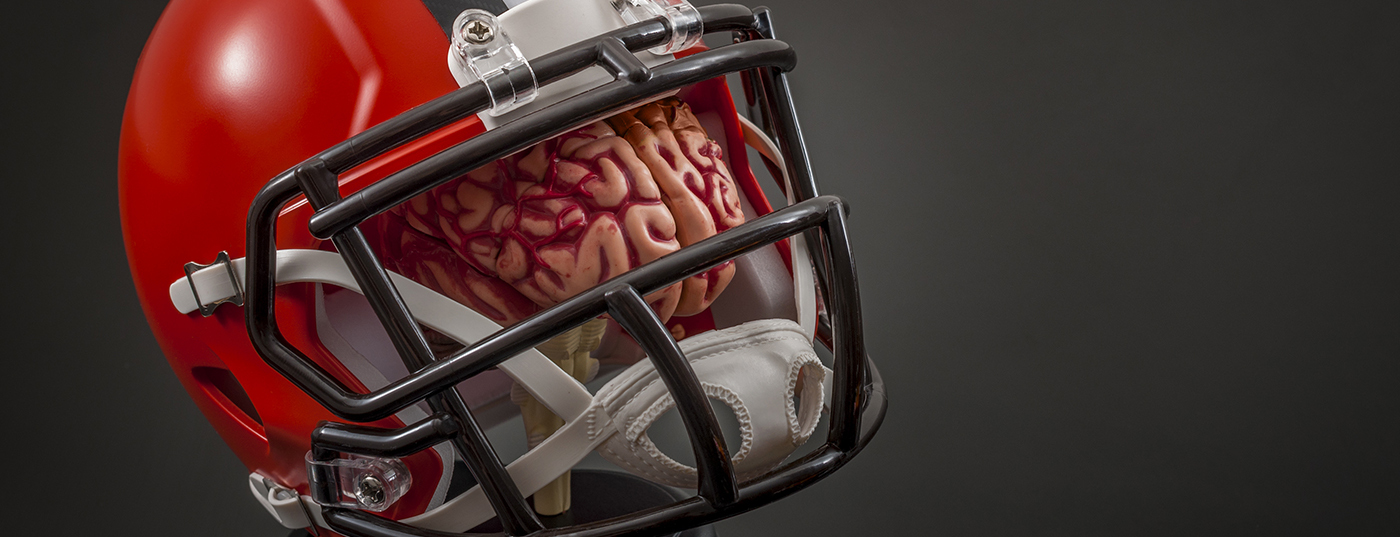A study from Scotland shows that professional football players have a 3.5 times higher risk of developing a neurodegenerative disease later in life compared to the general population. Players in defensive positions even had a fivefold increased risk. The cause is thought to be repetitive head contusions, which can cumulatively lead to chronic traumatic encephalopathy. As consequences resulting from the data, special protective measures could be discussed in the future – for example in training, since exposure was particularly high here.
Two years ago, a cohort study from Scotland [3] showed that professional football players have significantly higher mortality rates from neurogenerative diseases (Parkinson’s disease, Alzheimer’s disease, and other dementias) and motor neuron diseases such as ALS than in comparison groups in the general population. Overall, professional soccer players were three times more likely to have neurodegenerative principal diagnoses on the death certificate (1.7% versus 0.5%). At that time, however, several questions had remained unanswered. Therefore, this retrospective cohort (consisting of 7,676 former professional soccer players and over 23,000 control subjects matched for age, gender, and social status from the general population) has now been further analyzed [1]. For the first time, possible associations of risk for developing neurodegenerative diseases were identified in relation to soccer players’ field position, length of professional career, and birth cohorts. The total follow-up time was 1,812,722 person-years. In addition to death statistics (death certificates), diagnosis was established by linking individual mental health, hospitalization, and medication prescription data in the Health Register in Scotland.
As a result, neurodegenerative disease was identified in 386 of 7,676 former professional football players (5%) and 366 of 23,028 matched controls (1.6%) (HR 3.66; p<0.001). Players in defensive positions were affected most frequently, by a factor of 5 (HR 4.98). Goalkeepers did not have a significantly increased risk compared to the general population (HR 1.83; p=0.08). Career length was also critical: for example, the risk was highest for a professional career of more than 15 years (HR 5.2; p<0.001). With respect to birth cohorts, the risk was similar for all players born between 1910 and 1969.
The authors see the results as confirmation of the hypothesis that repeated head injuries, even if they were not severe traumatic brain injuries, can increase the risk of neurodegenerative diseases or so-called chronic traumatic encephalopathy (CTE), as players in defensive positions had a significantly higher risk than other field players. The association with career length argues for an importance of cumulative exposure.
The authors emphasize that the playing era had no influence on the results, although in the course of the 20th century the ball material was changed: With identical dry weight, the leather cover of soccerballs was replaced by a synthetic cover that could no longer soak up water. However, the current data do not allow us to determine whether this material advantage had an impact on CTE risk because too few players could be included in the study who had played exclusively in the era of synthetic balls.
Furthermore, another study – but on American football [2] – showed the actual number of skull contusions per player per season: it is a median of 415 (IQR 190-727) impacts! Interestingly, exposure was greater in training than in competition – even in amateur sports. The authors see clear implications here for prevention or the development of head protection strategies. “Chronic traumatic encephalopathy (CTE) caused by repeated low-grade head injuries in sports such as boxing, soccer, American soccer, rugby, or ice hockey is always a subject of discussion,” explains Prof. Hans-Christoph Diener, MD, press officer of the DGN. “Thus, protective measures can make perfect sense and have already become established in many high-risk sports. In light of the data, head protection should now be considered in soccer as well. This could be cushioning helmets or other novel developments, such as a special impact protection device approved by the FDA this year [4]. “roman
Literature
[1] Russell ER, Mackay DF, Stewart K et al. Association of Field Position and Career Length With Risk of Neurodegenerative Disease in Male Former Professional Soccer Players. JAMA Neurol 2021; 78 (9): 1057-1063 doi: 10.1001/jamaneurol.2021.2403.
[2] McCrea MA,Shah A,Duma S et al. Opportunities for Prevention of Concussion and Repetitive Head Impact Exposure in College Football Players: A Concussion Assessment, Research, and Education (CARE) Consortium Study. JAMA Neurol 2021 Mar 1; 78(3): 346-350 doi: 10.1001/jamaneurol.2020.5193.
[3] Mackay DF, Russell E, Stewart K et al. Neurogenerative disease mortality among former professional soccer players. NEJM 2019; 381 (19): 1801-1808 doi:10.1056/NEJMoa1908483
[4] FDA NEWS RELEASE: FDA Authorizes Marketing of Novel Device to Help Protect Athletes’ Brains During Head Impacts. February 26, 2021. https://www.fda.gov/news-events/press-announcements/fda-authorizes-marketing-nov…











